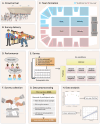Divisive negative discourse biases social experience: a live experiment at a massive public event
- PMID: 40785756
- PMCID: PMC12331517
- DOI: 10.1057/s41599-025-05652-8
Divisive negative discourse biases social experience: a live experiment at a massive public event
Abstract
Linguistic choices, crucially including negatively valenced words and divisive messages, can bias people's feelings, thoughts, and judgments. However, these phenomena have been typically captured with small groups in controlled settings, casting doubt on their robustness and ecological validity. Here we examined whether such effects hold in a massive public gathering. During a large TEDx event (n = 3139), participants engaged in an interactive musical game and then evaluated their perception of (active and vicarious) enjoyment and (ingroup and outgroup) performance through surveys that manipulated (a) the initial framing ('divisive' or 'communal') and (b) the questions' valence ('positive', 'neutral', 'negative'). Results showed that negatively valenced words reduced enjoyment and performance ratings, particularly under divisive framings. Active enjoyment also decreased under communal framings. These results were corroborated upon adjusting for sociodemographic variables. Briefly, linguistic manipulations of affect immediately altered a crowd's perception of enjoyment and performance. These insights extend psycholinguistic models and contribute to discussions on public communication.
Keywords: Language and linguistics; Psychology.
© The Author(s) 2025.
Conflict of interest statement
Competing interestsJN is part of the editorial board of this journal at the time of submission.
Figures


Similar articles
-
Measures implemented in the school setting to contain the COVID-19 pandemic.Cochrane Database Syst Rev. 2022 Jan 17;1(1):CD015029. doi: 10.1002/14651858.CD015029. Cochrane Database Syst Rev. 2022. Update in: Cochrane Database Syst Rev. 2024 May 2;5:CD015029. doi: 10.1002/14651858.CD015029.pub2. PMID: 35037252 Free PMC article. Updated.
-
Short-Term Memory Impairment.2024 Jun 8. In: StatPearls [Internet]. Treasure Island (FL): StatPearls Publishing; 2025 Jan–. 2024 Jun 8. In: StatPearls [Internet]. Treasure Island (FL): StatPearls Publishing; 2025 Jan–. PMID: 31424720 Free Books & Documents.
-
"In a State of Flow": A Qualitative Examination of Autistic Adults' Phenomenological Experiences of Task Immersion.Autism Adulthood. 2024 Sep 16;6(3):362-373. doi: 10.1089/aut.2023.0032. eCollection 2024 Sep. Autism Adulthood. 2024. PMID: 39371355
-
Autistic People's Experience of Empathy and the Autistic Empathy Deficit Narrative.Autism Adulthood. 2024 Sep 16;6(3):321-330. doi: 10.1089/aut.2023.0001. eCollection 2024 Sep. Autism Adulthood. 2024. PMID: 39371354
-
Factors that influence participation in physical activity for people with bipolar disorder: a synthesis of qualitative evidence.Cochrane Database Syst Rev. 2024 Jun 4;6(6):CD013557. doi: 10.1002/14651858.CD013557.pub2. Cochrane Database Syst Rev. 2024. PMID: 38837220 Free PMC article. Review.
References
-
- Adinda Puspa Nur F, Sholikhah IM, Muttaqin U (2022) Donald J. Trump’s protest response: rhetorical language of his speech at the “Save America” rally. J Engl Lang Stud 4(3):214–226. 10.31849/elsya.v4i3.10419
-
- Ajzenman N, Cavalcanti T, Da Mata D (2023) More than words: leaders’ speech and risky behavior during a pandemic. Am Econ J Econ Policy 15(3):351–371. 10.1257/pol.20210284
-
- Armstrong RA (2014) When to use the Bonferroni correction. Ophthalmic Physiol Opt 34(5):502–508. 10.1111/opo.12131 - PubMed
LinkOut - more resources
Full Text Sources
